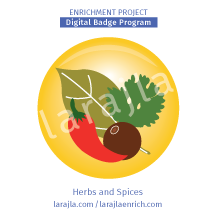 “Spice” up your life with the foods you eat. Herbs and spices can bring out flavors in your food or provide a completely new experience.
“Spice” up your life with the foods you eat. Herbs and spices can bring out flavors in your food or provide a completely new experience.
For this badge program, the use of the word “herbs” covers both herbs and spices unless otherwise noted.
Steps
1. Herbs vs. spices.
Do you know the difference? Herbs come from the leafy part of a plant and usually from a plant without a “woody” stem. Spices come from seeds, fruits, roots and bark and tend to be from tropical plants. Some plants provide both herbs and spices. Do a little investigation about the herbs and spices you use to find out where the come from and which category each falls into.
2. Local herbs.
Find out what herbs are in your local supermarket and / or farmer’s market. Check both fresh and dried varieties. What dishes that you enjoy could you put these herbs into? Are there any native plants that can be utilized in your recipes?
3. Non-local herbs.
Find herbs online, via mail order or even from another town. Again, check the fresh and dried varieties. How can you incorporate them into your cooking?
4. Herb variations.
You can find recommendations for replacing one herb with another. Look at your favorite recipes and see what you might change. Purchase an herb or two to find if they will compliment your dish. Try replacing one herb with another or adding one that you feel might add to the dish’s flavor. Keep track of your experiments and note whether you liked the result.
5. More than food.
Herbs can also be used in drinks such as tea or non-alcoholic cocktails. This might be as simple as adding mint. Explore the possibilities.
6. Dry vs. fresh.
Try using dry and fresh herbs in one or more of your dishes. What are the differences? Do you need to take extra steps with a fresh herb? Which do you prefer?
NOTE: You can also replace other ingredients, such as salt, with herbs.
7. Rubs.
Mix herbs to make your own unique rub for the meat of your choice. Use recipes from others or make your own. If you don’t eat meat, create mixes for your vegetables.
8. Grow your own.
Perhaps you want to grow something you buy all the time or found something online you love that you can’t get fresh locally. Try growing your own herbs. Find others in your area who also grow their own herbs. Can you trade with them to increase your variety?
9. Drying and storage.
Try drying and storing your herbs. Explore different techniques and storage systems.
10. Share special blends.
Share some of your herbs with others or invite friends over for a taste to let them explore herbs too!
Supplements
SUPP_Herbs Spices_2in_12up_larajla
- Avery 2.5” round label printable, 12 up
SUPP_Herbs Spices_Checklist_larajla
- Badge checklist
Sites to Explore
- en.wikipedia.org/wiki/List_of_culinary_herbs_and_spices
- en.wikipedia.org/wiki/Herbal_tea
- homecooking.about.com/library/archive/blherb2.htm
- www.pinchmeimeating.com/sweet-herb-infused-drinks
- lovelygreens.com/2015/01/15-mocktails-made-with-garden-herbs.html
- www.theepicentre.com/Spices/spiceref.html
- www.savvygardener.com/Features/herbs.html
- urbanext.illinois.edu/herbs/list.cfm
- culinaryherbguide.com
- www.livestrong.com/article/202409-how-do-i-replace-dried-herbs-with-fresh-herbs
- www.ehow.com/how_7528553_replace-salt-herbs-spices.html
- www.i-love-creative-cooking.com/Seasoning-chart.php
Get the infographic here > larajla blog post
Get the PDFs of the badge program / supplements here > Full badge PDFs